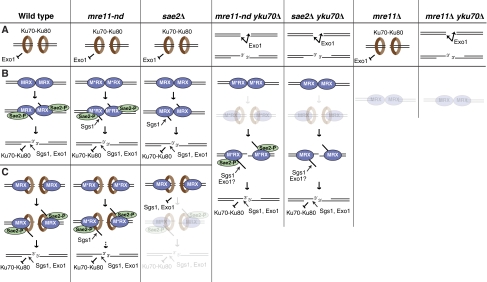Figure 7.
Models for the interplay between resection machinery and Ku at DSB ends. In wild-type cells, DSBs can exist in three dynamic states: (A) Ku-bound, which blocks access to Exo1, (B) MRX-bound, which can initiate end processing and (C) MRX-Ku-bound, which can initiate NHEJ and removal of Ku is required to allow resection initiation. Recruitment of Sae2 in G2 and clipping of the ends allows access to the processive resection machinery and creates an intermediate that can no longer convert states and commit to HR. In nuclease-defective mutants of Mre11, though compromised for initial processing, the presence of Sae2 channels ends to HR and redundant activity from Sgs1-Dna2 allows initiation of resection. In the absence of SAE2, the MRX-bound ends can still initiate resection, presumably with some assistance by Sgs1, whereas the Ku-bound and MRX-Ku-bound ends are blocked. When the end protection by Ku is lost, in mre11-nd yku70Δ and sae2Δ yku70Δ for example, MRX-naked ends can be resected by Exo1. For the MRX-bound ends even if compromised for the initial clipping, the absence of Ku allows Sgs1 (and maybe Exo1) to assist in initiating resection of the DSB. Finally, in the absence of Mre11, where the only state present is the Ku-bound state, access of Exo1 is blocked in a Ku-dependent manner.

